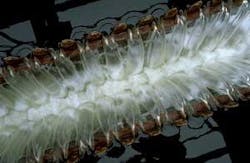New Treatment Plant to Feature Ceramic Membranes
By Nathen Myers
The Parker Water and Sanitation District (PWSD) in Colorado has contracted for a membrane treatment system for its Rueter-Hess water treatment plant project. The new plant will treat water from the Rueter-Hess Reservoir (RHR), which is being built three miles southwest of downtown Parker on Newlin Gulch, which is a tributary drainage of Cherry Creek.
The reservoir and associated treatment plan will help the city address its long-term water shortage problems.
Water from the reservoir will be used by residents for everyday water needs, to replenish the underground aquifer, and as a reserve for better water management during a drought. The Rueter-Hess Reservoir is estimated for completion in 2010 and anticipated to begin filling in 2011.
Average dissolved organic carbon (DOC) levels in the raw water from the 1,100-acre reservoir are expected to be 6 mg/L or higher. Algae growth within the reservoir could increase DOC concentrations up to 10 to 12 mg/L, especially during the summer. The high DOC could result in high disinfection-byproducts (DBP) formation potential following chlorine disinfection.
The treatment system selected for the new Reuter-Hess water treatment plant will feature Kruger's Opaline Process design including the Actiflo® Turbo, Actiflo® CARB and Kruger Ceramic Membrane (KCM).
Kruger worked with PWSD's engineer Integra Engineering and the membrane supplier METAWATER on the design, evaluation, and selection phases of the project. The new water treatment plant will be constructed to treat the RHR water and will initially operate seasonally for irrigation purposes.
Kruger's Opaline process was selected as the preferred process due to its flexibility and ability to produce a higher quality of water. The process also will allow PWSD to meet the requirements of any future safe drinking regulations.
The treatment process will use a three stage design that includes enhanced coagulation, powdered activated carbon (PAC) contact and microfiltration.
First Stage
The enhanced coagulation stage will feature Kruger's latest R&D developments that use a draft tube in the maturation zone allowing for optimum mixing. The Actiflo Turbo Process is a high performance, compact clarification system that uses micro-sand for enhanced flocculation and settling. The micro-sand ballasted flocculants display unique settling characteristics, which allow for clarifier designs with very high overflow rates and short retention times. The design results in footprints that are 20 times smaller than conventional clarification systems.
Second Stage
The second stage will consist of the Actiflo® CARB process, a PAC recirculation system meant to remove natural organic matter in the form of DOC to minimize disinfection-byproduct formation. The activated carbon slurry is a onetime charge into the system and is recycled within the process to maximize feed-water contact while minimizing the fresh PAC dose. The initial PAC charge is predicted to be 4 g/L.
The settled material (sand, flocculated particles and PAC) are pumped to a hydrocyclone. The sand is separated from the settled material and returned to the process while the sludge and PAC are sent to an intermediate tank which allows for PAC recovery and thickening of the sludge prior to leaving the system. Used PAC is continuously extracted from the system and replaced by fresh PAC at a rate of 5 to 30 mg/L depending on levels of total organic carbon.
Final Stage
The final stage will feature the Kruger Ceramic Membrane technology, a state-of-the-art ceramic membrane that offers improved mechanical strength and uniform pore size. The membrane system employs monolithic internal pressure-type ceramic membrane elements, each with 269 ft² of membrane surface area. The ceramic elements supplied by METAWATER have been employed in over 70 installations. Since the first installation 11 years ago, no ceramic membrane system has experienced failure. This represents no breakage in over 17,000 elements.
Each element offers microfiltration through 0.1 µm size pores that completely remove impurities such as turbidity, E-coli bacteria and cryptosporidium (pathogenic protozoa) contained in raw water. Due to the meticulous practices used to construct the membrane, the pore size distribution of 0.1 microns size is 95%.
Combination with coagulation provides the opportunity for additional organic removal while maintaining reliable performance under varying conditions. As a result of the robust ceramic structure, the system is backwashed at 70 psi every 60-90 minutes, which results in recovery of at least 98%.
The ceramic membranes supplied with KCM systems have an expected life of 20 plus years and should not need replacing during the projected life of the facility. This allows for a membrane warranty of 20 years to be supplied with the system. --m
About the Authors:
Nathen Myers received his bachelor’s degree in environmental engineering from Louisiana State University and is currently pursuing his MBA. He has worked in both the petro-chemical and water industries with a focus on technologies such as UV disinfection, clarification, membranes, and filtration. He currently works with Kruger as the Technical Account Manager responsible for membrane systems in the United States.

